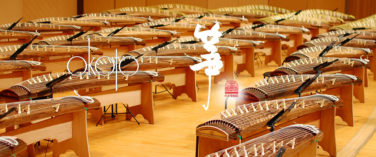Prior to the Japanese Koto Concert “Koto~Beyond Horizons” (Sunday, October 6th, 3 pm at the Agnes Flanagan Chapel, Lewis and Clark College), professional koto players from throughout the US and Japan will give presentations at the Cultural Corner on Saturday, October 5th.
Players include Masayo Ishigure, known for her musical performance on the “Memoirs of a Geisha” (2005) movie soundtrack, as well as other members of the Sawai Koto Institute who have studied under Kazue Sawai, the featured guest artist of Oregon Koto-Kai’s Sunday concert.
The Sawai Koto Institute was founded in 1979 by koto master/composer, Tadao Sawai (1937 – 1997) along with his wife, world renowned koto and jushichigen (17 string bass koto) master, Kazue Sawai. Tadao Sawai has composed numerous pieces from solo koto to ensemble music. In his compositions he incorporated many elements of traditional Japanese music yet he often sought new musical direction and was constantly inspired by musicians in various genres. Both Tadao and Kazue had a strong desire to introduce koto to the world, because they felt most people in Japan were constrained by stereotypes which restricted this beautiful instrument in a cage of “Tradition”. Their deep belief was that “tradition was created by innovation”, and through their efforts they sought to create modern koto music by expressing koto in different styles with different artists, introducing koto to the outside world, and training excellent students to carry on their legacy. Through an encounter with John Cage, Kazue Sawai was invited to perform at ‘Bang on a Can Festival’ in 1990. This brought attention to her from a ‘non-steryotyped’ audience who recognized her virtuosic musical performance, and inspired many students from different countries to begin studying koto. Today, Tadao and Kazue Sawai’s students are performing internationally, and their son, Hikaru Sawai has been creating 21st century koto music which continues to attract younger generations.
About the Koto
The koto is one of the most famous of all the traditional Japanese musical instruments. Originating in China, these 13-string zithers first appeared in Japan during the Nara Period (710–784). Following the example of its Chinese ancestor, the koto was played in Imperial court music known as Gagaku. The instrument quickly found favor among the aristocracy, and was even featured in “The Tale of Genji”, a work written in early 10th century (middle Heian Period) often called the world’s first novel. Throughout a turbulent history, the Koto and its secret repertoire managed to survive and was preserved largely through female practitioners. It wasn’t until the Edo period (1600 – 1867), that a true revolution took place and the gifted blind musician Yatsuhashi Kengyo, called the “Father of Modern Koto”, developed his own techniques and began offering lessons to amateurs. By the dawn of the Meiji Restoration the Koto, and its new song-based repertoire, enjoyed extraordinary popularity among ordinary people. Today, the Koto is recognized as one of Japan’s national treasures and people around the world continue to enjoy its beautiful, timeless sound.
